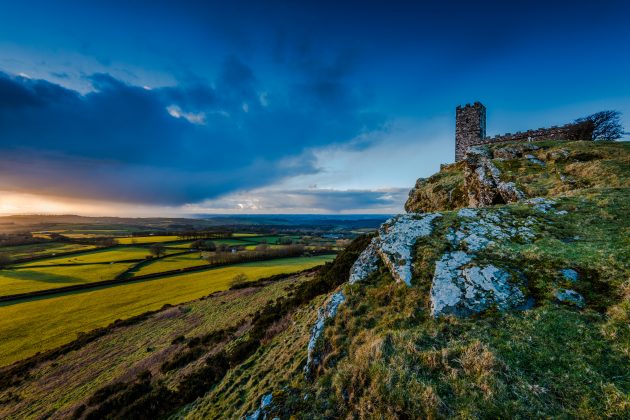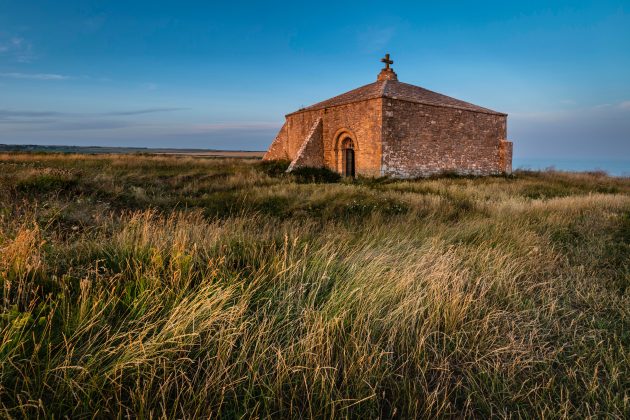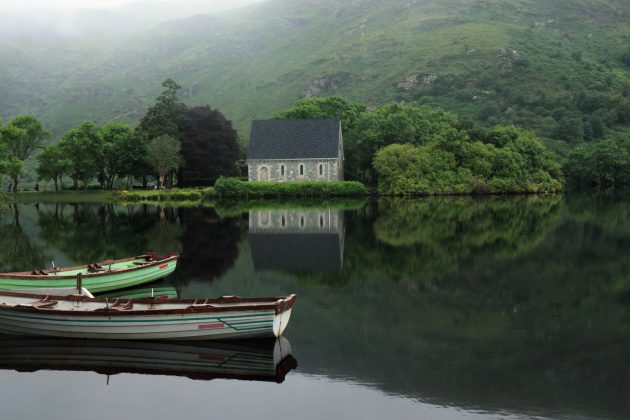Churches and chapels in inaccessible or isolated spots are worth seeking out, often offering an experience quite unlike any other, says Ettie Neil-Gallacher
There is something so intensely moving about remote churches and other places of worship. Perched on the top of a cliff, nestled into some isolated hillside or buffeted by sea breezes and saltwater spray, churches, chapels and even shrines in out-of-the-way locations are a bold statement. They are beacons of belief – a bricks-and-mortar apologia of an ancient faith, born of hope and proud defiance of nature’s adversity.
THE MOST REMOTE CHURCHES AND CHAPELS

Mont-Saint-Michel Abbey in Normandy
There are, of course, many remote churches across the world that are, rightly, famous: the monasteries of Meteora in Greece, and even Mont-Saint-Michel on its rocky, tidal island in Normandy. Some, indeed, deserve to be more famous; examples that spring to mind include the Chapel of Our Lady of the Snows, carved out of ice in Antarctica, and the Church of St Maximus the Confessor in a remote part of Georgia, which can only be visited by men, and men brave enough to climb the 130ft rusty ladder bolted on to the sheer face of the limestone monolith on which it stands.

the monasteries of Meteora, Greece
And while there are few areas of Britain that haven’t been well and truly discovered, there are still isolated corners where chapels and churches can, with a bit of effort, be sought out or even stumbled across. This effort is worth making for many, many reasons: cultural, historical, spiritual. But it wasn’t until I was in my late twenties that I realised this.
THE GLORIES OF WALES
During my first maternity leave, I went on a road trip around Wales with my then infant daughter – a sub-optimal travel companion, perhaps. While my brain was undoubtedly befuddled, there was at least a degree of method in my madness: the only place she slept was the car, so I reasoned that I might be less assaulted by her soul-savaging screaming and could concurrently marvel at the glories of Wales’ seemingly infinite wonders.
Having driven into Wales from Hay-on-Wye over the Gospel Pass, in all its fabled splendour, my daughter, Bea, and I spent several days exploring the Brecon Beacons. In an area where many sights border on the transcendent, one particular experience would remain ineffable for years. On the recommendation of our B&B owner, we headed towards the tiny village of Patrishow to visit a chapel there. I say ‘village’ but saw little evidence of any sort of settlement: there were no houses or farms, as far as I could tell. Indeed, I don’t recall seeing a single other person.
But I persevered with the instruction to keep driving up the hill. The B&B owner had warned me that it was prohibitively narrow and circuitous but we continued to wind our way up in first gear, navigating the hairpin bends for what seemed like an eternity. Just as I was beginning to suspect that he was in fact an English-hating militant Welsh nationalist who felt a mother and baby in an ancient Volvo were fair game, the Grade I-listed, 11th-century church of St Issui came into view.
The patron saint was a sixth-century Celtic martyr, who lived in a prayer cell by the well next to where the church would be built. It is said that he was murdered by a traveller to whom he had given refuge. Given how remote the location seems today, when we can explore almost every crevice and corner of the globe, the isolation St Issui sought out a millennium and a half ago must have been hauntingly total. And while the setting takes one’s breath away, I wasn’t quite prepared for the experience I would have when we explored the church itself.

the Church of St Issui, Powys
HEALING WATERS
The altar stands over the spot where St Issui was murdered, and the waters around the church are reputed to have healing properties. Much has been written by architectural historians about the Gothic perfection of the church, with its 1,000-year-old font, magnificent rood screen and didactic wall paintings for an illiterate congregation. There’s a macabre fascination to the Doom figure on the western wall – an eerily detailed skeleton with a scythe, hourglass and spade (and far too many ribs), which has reputedly been whitewashed several times over the centuries, and yet always reappears.
But when it came to relaying to others the details of this excursion, I found that I was at a loss as to how to describe my experience – at least beyond describing its remoteness and its spectacular physical features – for it was so much more than the sum of its parts.
My tongue-tied struggle was resolved only last year – some 14 years later – when I stumbled across the idea of thin places in an article in the New York Times. As I read on, I thought immediately of my first visit to the church in Patrishow. Thin places, I learned, are a Celtic notion: places where the interface between Heaven and Earth collapses, and us mere mortals can glance at the divine. They’re places where we are sufficiently freed from earthly distractions to be able to sense the celestial more directly. While thin places are often sacred, they don’t have to be.

St Just in Roseland Church on the Fal, where Diccon Rogers was married
And while thin places might be an early Christian concept, the idea would surely resonate with all but the most hardened atheist. One doesn’t need to be religious to appreciate the idea of earthly locations where one feels an intimate sense of the transcendent, a sense of contact with something greater, something beyond the earthly bounds to which we’re subject.
Diccon Rogers, owner of Cornwall-based industrial marine salvage operators Keynvor Morlift and a man of self-confessed “zero faith”, finds himself stirred by certain remote Cornish churches. Confronted with chapels such as the Rame Head church overlooking Plymouth Sound or the churches of the River Fal, he discovers himself “muddling along between Philip Larkin’s Church Going and TS Eliot’s Four Quartets”.

Rame Head Chapel in south-east Cornwall is dedicated to St Michael
THIN PLACES IN THE THICK OF IT
Others have reported experiences of thin places in frenetic city centres; indeed, in my left-footed fashion, I can think of several churches in Rome (in the midst of all the chaos and traffic and noise and graffiti) that are thin places for me. But remote and isolated places surely lend themselves to being thin places more readily. Solitude can lead to reflection, reflection to introspection, introspection to thoughts of things beyond and greater than ourselves. Thus a remote location sets the scene for the collapse of that interface.
Sometimes this collapse can have lasting repercussions. Journalist Flora Watkins had just such an experience many years ago at the “exquisite” church of Our Lady Immaculate & St Edmund in Suffolk, which has been described as the most remote church in East Anglia. Lying above the ancient Dedham Vale, with no other building for half a mile apart from the house attached, Watkins says that it was here that “I found God. Or rather he found me.” She recalls an Easter Vigil Mass there. “It started in the dark, with the sheep baa-ing, like something out of Thomas Hardy,” she says.
SITING OF EARLY CHURCHES
So why were these remote chapels and churches built in the first place? In the very early days of Christianity, communities of believers simply met in each other’s houses. Church building only really began in earnest in the 11th century, and would continue with great fervour for another three centuries. Some were built in existing holy places or on pilgrimage routes but, in general, a church was built where there was a community to use it, and the disparate locations of these churches and chapels reflects societal demand in pre-industrialised Britain.
Many of the most striking remote chapels are by the sea. Some – such as St Govan’s Chapel in Bosherton, Pembrokeshire, and the Rhu Church on the Isle of Canna in the Inner Hebrides – are almost actually in the briny deep. Why they were built so precipitously close to the sea is a matter for speculation but it was probably because it was believed that such a structure would act as some sort of sacred talisman, providing guidance and safe passage to seafarers tossed about on the merciless waters.

St Govan’s Chapel in Pembrokeshire, South Wales, is a tiny hermit’s cell built into the cliff
While these churches and chapels must surely lend themselves to being thin places, the experience is purely individual. Regardless, it would equally be impossible not to marvel at the sheer devotion that must have made their existence possible.
TOP FIVE REMOTE CHURCHES
In addition to the churches already mentioned, here are The Field’s top five remote churches and chapels.
BRENTOR CHURCH, NEAR NORTH BRENTOR, DEVON

The fourth smallest parish in the UK is also thought to be the highest, perched atop a Dartmoor tor. Although founded in the 12th century, most of what we see today is 13th and 14th century. This Church of England chapel holds regular Evensong services in the spring and summer, and occasional services throughout the year.
CHAPEL OF CHRIST CHURCH, ENSAY, OUTER HEBRIDES
This tiny chapel sits on an uninhabited, privately owned island in the Sound of Harris, between Harris and Berneray. Thought to date from the 11th century, it was restored during the Edwardian period and rededicated on St Columba’s Day, 9 June 1973. Biannual services are held there, and each year up to 60 people make a pilgrimage across the sea as near as possible to St Columba’s Day.
ST ALDHELM’S, WORTH MATRAVERS, DORSET

The Grade I-listed Norman chapel stands on St Aldhelm’s Head, high above the sea. The shape and design are puzzling but the structure doubled as a look-out for Corfe Castle. Having fallen into disrepair, it was restored in the 19th century. Although its fortunes have waxed and waned, today services are held on special occasions, including a dawn service on Easter Sunday.
ST FINBARR’S ORATORY, GOUGANE BARRA, CO CORK

While the church itself only dates back to 1700, it was built on a hermitage where St Finbarr is said to have spoken to God back in the sixth century. Standing on its own island in the shadow of the Shehy Mountains, its remoteness made it a relatively safe place for Catholics to practise during the 18th century.
ST ELIDIUS’ ORATORY, ST HELEN’S, ISLES OF SCILLY
St Elidius’ Oratory is something of an exception on this list because the other churches and chapels are all not only still standing but are active places of worship, at least occasionally. But this ruin, on an uninhabited island, was a place of pilgrimage for centuries. According to the Viking sagas, Olaf Tryggvason, having raided and pillaged his way to the Isles of Scilly, met a seer here and this prompted his conversion to Christianity, which he then brought back to Norway where he duly became king.




